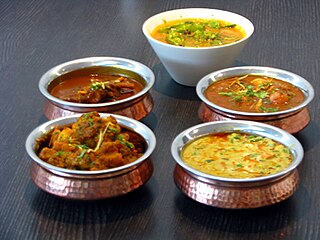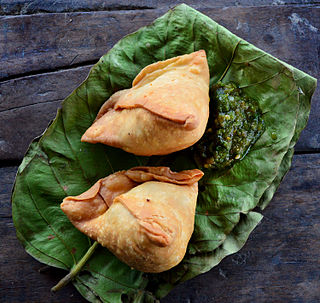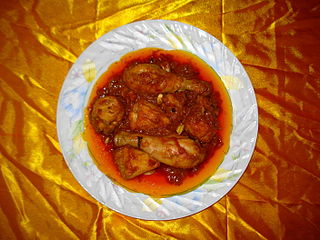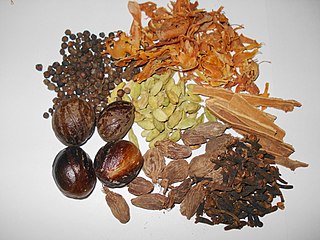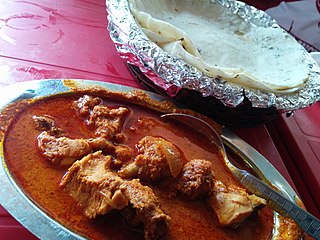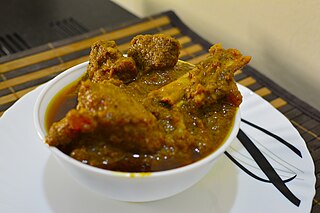This article needs additional citations for verification .(August 2023) |



Indian spices include a variety of spices grown across the Indian subcontinent (a sub-region of South Asia). With different climates in different parts of the country, India produces a variety of spices, many of which are native to the subcontinent. Others were imported from similar climates and have since been cultivated locally for centuries. Pepper, turmeric, cardamom, and cumin are some examples of Indian spices.
Contents
Spices are used in different forms: whole, chopped, ground, roasted, sautéed, fried, and as a topping. They blend food to extract the nutrients and bind them in a palatable form. Some spices are added at the end as a flavouring — those are typically heated in a pan with ghee (Indian clarified butter) or cooking oil before being added to a dish. Lighter spices are added last, and spices with strong flavour should be added first. "Curry" refers to any dish in Indian cuisine that contains several spices blended together, whether dry or with a gravy base. However, it also refers to curry leaves, commonly used in South India.
Below is a list of spices and other flavouring substances commonly used in India. [1]
| Image | Standard English | Notes |
|---|---|---|
| Alkanet root | (Hindi: Ratanjot) | |
| Amchoor | Raw unripe mango is sun-dried and then ground to fine powder. (Hindi: Amchoorआमचूर) | |
 | Asafoetida | Intensely aromatic - flavor profile sometimes compared to that of truffles and garlic. Used as a tempering spice. (Hindi: Hingहिंग) |
 | Bay leaf, Indian bay leaf | Both Indian bay leaf and bay leaf are similar and called tej patta in Hindi. However, they are from two different species and have differences in taste. Used as a tempering spice. (Hindi: Tej Pattaतेज पत्ता) |
 | Black cardamom | Very earthy and darkly aromatic. Often used in North Indian curries. Used as a tempering spice. (Hindi: Badi Elaichiबड़ी इलाइची) |
 | Black peppercorns | Pepper may be used whole or ground in Indian cuisines. The largest producer is the southern Indian state of Kerala. Used as a tempering spice. (Hindi: Kali Miriकाली मरी) |
 | Charoli | Also known as chironji, Cuddapah almond or almondette; a type of nut particularly used in making desserts. (Hindi: Chironjiचिरोन्जी) |
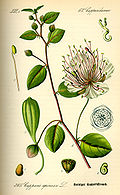 | Capers | They are immature flower buds of Capparius spinosa, also known as caper berry. (Hindi: Kabraकब्र) |
 | Capsicum or bell pepper | (Hindi: Shimla Mirchशिमला मिर्च) |
 | Caraway seeds | Used as a tempering spice. (Hindi: Shahijeeraशाहजीरा) |
 | Carom seeds | Also known as bishop's weed, they are different from celery seeds and radhuni seeds Used as a tempering spice. (Hindi: Ajwainअजवायन) |
| Cassia buds | Also known as Mesua ferrea; the unopened flowers of the cinnamon tree that are picked just before blooming and dried in the sun. Used in Ayurveda for treating fever, vomiting, UTIs, migraines, etc. Also used in Chyavanprash. Used as a tempering spice. | |
| Char magaz | A mixture of four types of melon seed kernels (watermelon, cantaloupe, cucumber, pumpkin). (Hindi: Char Magazचार मगज) | |
 | Cinnamon | Grown commercially in Kerala in southern India. Two types, cassia (common) and royal. Used as a tempering spice. (Hindi: Dalchiniदालचीनी) |
 | Citric acid | |
 | Cloves | Kerala, Tamil Nadu, and Karnataka are largest producers in India. Used as Tempering Spice. (Hindi: Laungलौंग) |
 | Coriander seed | Also used in powdered form. Used as a tempering spice. (Hindi: Sabut Dhaniyaसाबुत धनिया) |
 | Cubeb or tailed pepper | Tastes of clove with added bitterness with a persistent mild numbing sensation (Hindi: Sheetal Cheeniशीतलचीनी/Kabab Cheeniकबाब चीनी) |
 | Cumin seed | Used as a tempering spice. (Hindi: Jeeraजीरा) |
| Cumin seed ground into balls | ||
 | Curry leaf or sweet neem leaf | Foliage of the curry tree. Cannot retain flavour when dried. Only used fresh. (Hindi: Kari Pattaकरी पत्ता) |
 | Fennel seed | Used as natural mouth-freshener. Used as a tempering spice. (Hindi: Saunfसौंफ) |
 | Fenugreek leaf | (Hindi: Methiमेथी) |
| Dry Fenugreek leaves | It is rubbed gently in the palms of the hands and sprinkled over the cooked dish towards the end. (Hindi: Kasuri Methiकसूरी मेथी) | |
 | Fenugreek seed | Used as a tempering spice. (Hindi: Methi danaमेथी दाना) |
 | Garcinia gummi-gutta | Used in fish preparations in Kerala |
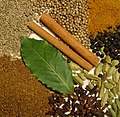 | Garam masala | Blend of eight or more warming spices. Each family has its own recipe. (Hindi: Garam Masalaगरम मसाला) |
 | Garcinia indica | Used mainly in Maharashtrian Konkan and Gujarati cuisine. It has a sour taste with a faintly sweet aroma. (Hindi: Kokamकोकम) |
 | Garlic | (Hindi: Lassonलहसुन) |
 | Ginger | (Hindi: Adarakअदरक) |
 | Dried ginger | mostly powdered (Hindi: Sonthसोंठ) |
 | Green cardamom | Malabar variety is native to Kerala. Used as a tempering spice. (Hindi: Hari Elaichiहरी इलायची) |
 | Green chili pepper | (Hindi: Hari Mirchहरी मिर्च) |
 | Indian gooseberry | It is used in Chyavanprash. (Hindi: Amlaआंवला) |
 | Inknut | Also called haritaki. Used in Ayurveda for treating chronic ulcer, diarrhea, dysentery and piles. (Hindi: Haradहरड़) |
 | Jakhya | Also called dog mustard or wild mustard. Used in Garhwali and Kumaoni styles of cuisines. Tasteless and odorless when uncooked; earthy and crunchy when crackled in oil. (Hindi: Jakhyaजख्या) |
| Black Stone Flower | It has a strong earthy aroma and a very dry, light fluffy texture and feel to it. It is widely used in Chettinad cuisine and to some extent in Hyderabadi and Marathi cuisine. (Hindi: Pathar phoolपत्थर फूल) | |
| Guizotia abyssinica | Kaaral/khuraasni/raamtill | |
 | Liquorice powder | (Hindi: Mulethiमुलेठी) |
 | Mint leaves | |
 | Rose petals | |
 | Long pepper | Used in South Indian cuisines. (Hindi: Pippaliपिप्पली) |
| Kaachri | ||
| Mango extract | ||
| Marathi moggu | ||
 | Yellow mustard seed | Used as a tempering spice. (Hindi: Sarsonसरसों) |
 | Brown mustard seed | Used as a tempering spice. (Hindi: Raiराइ) |
| Naagkeshar | Used in Maharashtrian cuisine as one of the ingredients of godaa masaalaa. (Hindi: Nagkesharनागकेसर) | |
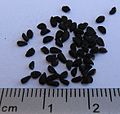 | Nigella seed | Gives smoky, nutty flavor; dry-roasted or used as a tempering spice (Hindi: Kalonjiकलौंजी) |
 | Nutmeg | (Hindi: jaayaphal जायफल) |
 | Mace | Mace is the outer covering of nutmeg nut and has a similar aroma. (Hindi: Javitriजावित्री) |
 | Panch phoron | This is a Bengali spice mix that combines fennel seeds, cumin seeds, fenugreek seeds, mustard seeds and nigella seeds. Used as tempering spices. |
 | Pomegranate seed | Dried and ground in the Middle East. (Hindi: Anardanaअनारदाना) |
 | Poppy seed | Very popular in West Bengal known posto, with no of Bengali cuisine, most popular Allu Posto (Hindi: Khas khasखसखस) |
| Pandanus (Screwpine) | (Hindi: Pulao Pattiपुलाव पत्ति/ Annapoorna Pattiyaanअन्नपूर्णा पत्तियां) | |
| Radhuni Seeds/Wild celery | It is dried fruit of Trachyspermum roxburgianum. Mostly used in Bengali Cuisine. (Hindi: Ajmodअजमोद) | |
 | Red Chili Pepper | (Hindi: Lal Mirchलाल मिर्च) Bhut Jolokia (Arunachal Pradesh, Assam, Manipur, and Nagaland). KashmiriMirch (Kashmir). Guntur Sannam (Andhra Pradesh). Jwala Chilli (Gujarat). Byadagi (Karnataka and Tamil Nadu). Ramnad Mundu/Gundu (Tamil Nadu and Andhra Pradesh). Dhani (Manipur and Mizoram). Kanthari (Manipur, Mizoram, Tamil Nadu, and Kerala). Warangal Chappatta (Telangana). Used as Tempering Spice. |
| Saffron pulp | Actually, safflower concentrate | |
 | Saffron | World's most expensive spice. Used for flavouring rice & desserts. (Hindi: Kesarकेसर) |
 | Sesame seed | Black Sesame seed (Hindi: Kala Tilकाला तिल) White Sesame seed (Hindi: Tilतिल) |
 | Star Anise | Exotic, Chinese-influenced flavours Used as Tempering Spice. (Hindi: Chakra phoolचक्र फूल) |
| Sichuan Pepper | Also known as Teppal/ Tirphal. (Hindi: Tirphalतिरपाल) | |
 | Tamarind | Provides tartness in South Indian curries. (Hindi: Imliइमली) |
 | Thymol/carom seed | Used as Tempering Spice. (Hindi: Ajwainअजवायन) |
 | Turmeric | It is used extensively in Indian cooking. It is also often used as a colourant. It has a warm, peppery taste with musky, earthy undertones. Raw Turmeric (Hindi: Kachi Haldiकच्ची हल्दी). Dry Turmeric (Hindi: Sukhi Haldiसूखा हल्दी). Ground Turmeric (Hindi: Haldiहल्दी). |
| Gum Tragacanth | A thickener and coating for desserts | |
 | White Peppercorns | Mostly used in white, cream based gravies/curries. (Hindi: Safed Mirchसफेद मिर्च) |
